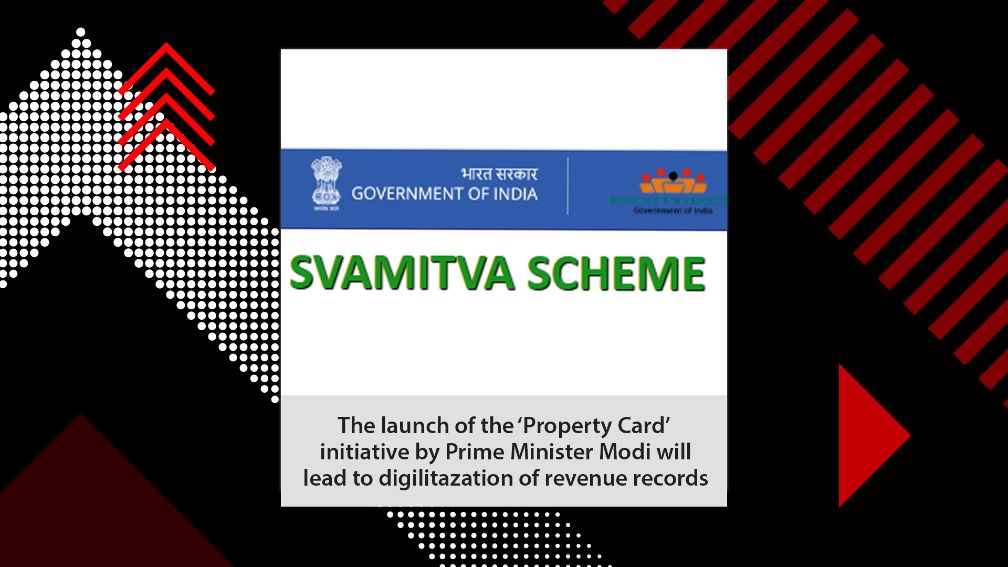Almost 90 crore people in India – three-times the population of America – live in villages and backward areas.
The launch of the first-phase of distribution of ‘Property Cards’ by the Prime Minister Narendra Modi recently is a landmark initiative under the SVAMITVA (Survey of Villages and Mapping with Improvised Technology in Village Areas) Scheme announced by the government in April this year.
The initiation of the property card distribution, as the Prime Minister asserts, is a “historic effort towards rural transformation” and takes India a step forward towards becoming “self-reliant.” The larger goal of the initiative is to enable the country’s vast rural population have a physical record of their land holdings and also enable them to monetise their ownership rights.
Why is record keeping important
Almost 90 crore people in India – three-times the population of America – live in villages and backward areas. The rural share is almost 70% of the country’s total population of 1.3 billion.
Often, the government and authorities face severe challenges in rural planning due to non-availability of veritable records of landholding and property ownership of this large size of population. Lack of accurate records lead to discrepancies in homeless and landless data, inaccuracies in landholding information, surveys and GIS maps, besides giving rise to legal disputes, which hampers rural investments, economic development and also drains the government exchequer.
A June 2019 study by Centre of Policy Research pointed out that Indian courts are clogged with land dispute cases, which comprise of 66% of all civil cases and 25% of all cases decided by the Supreme Court. An estimated 7.7 million people in India are affected by conflict over 2.5 million hectares of land, threatening investments worth $200 billion, the report said.
Getting documented details of land holdings in rural areas, like the shape, size and area of every land parcel, the ownership details and also the demographic distribution will not only enable better rural planning but also streamlining of property tax records and lessening of instances of property disputes.
The SVAMITVA scheme is the first significant initiative to regularise rural landholding and property records. The scheme entails surveying land parcels in rural areas using the ‘Drone Technology’ to gather and document rural records in a phase-wise manner. Around 6.62 lakh villages would be covered under the survey over a period of four years (from 2020 to 2024), which will be carried out by Survey of India.
Benefits of the property card
The government’s Rs 80 crore SVAMITVA Scheme envisages to meet six key goals. Besides creation of ‘record-of-rights’ for facilitating rural planning, reducing property disputes, improving property tax collections and enabling rural economic and infrastructure development, one of the key outcomes of the scheme is also issuance of property cards to property owners to allow them to monetise their assets and gain financial security. With the property card, the rural populace will now have a physical record of their land and also be able to use their property as a financial asset for taking loans and getting other financial benefits.
At a broader level, the launch of the ‘Property Card’ initiative by Prime Minister Modi will lead to digitization of revenue records, thus helping in the creation of a national database on land holdings for the first time.
Further, segregation of land parcels will now become easier as the survey will also provide information about land used for housing purposes. Till now, only data of land under cultivation, i.e. agricultural land, was available. With full clarity on land use and ownership, misuse of land parcels by vested interest parties can also be curbed to a great extent.
In the first phase of the initiative, property cards will be handed over to 1 lakh beneficiaries across 346 villages in UP, 221 in Haryana, 100 in Maharashtra, 44 in Madhya Pradesh, 50 in Uttarakhand and two in Karnataka. The first of these beneficiaries would be able to download their property cards through an SMS and later the respective state governments will carry out the physical distribution.
To Conclude:
While the launch of Property Cards under the SVAMITVA scheme is a commendable first step for rural transformation, the success of the initiative in regularising rural records and abating disputes can be truly gauged over a period of time.
Further, when the property card is used as collateral for loans, it will need to stand the test of its evidence value. Just holding the property card cannot be deemed as equivalent to a title document unless corroborated by valid documents. The financial institutions expected to provide loans against property cards by the government must also be adequately sanitised and sensitised.
Lastly, the launch of the property card alone won’t bring about rural transformation unless the land reforms are also initiated. The fact mustn’t be ignored that a large part of the government’s plans for economic resurrection and attracting foreign investments rests on the pillar of these long-overdue land reforms.
By Mr Ravindra Sudhalkar, CEO, Reliance Home Finance
DISCLAIMER: The views expressed are solely of the author and RealtyNXT.com does not necessarily subscribe to it. RealtyNXT.com shall not be responsible for any damage caused to any person/organisation directly or indirectly.
ALSO READ: India’s Economic Stimulus Packages: Grace For MSMEs Or Solution To A Larger Fiscal Problem?




























